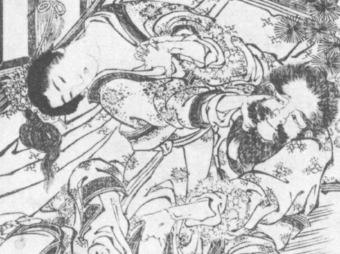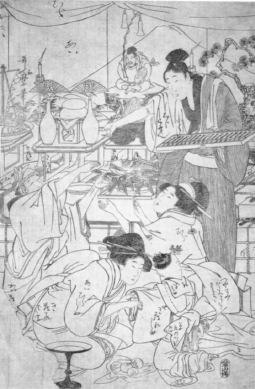'Traditional' vs 'Creative' printmaking
Woodblock printmaking in Japan has two main faces: traditional and creative. Those are not particularly accurate words to describe the two 'worlds', as the traditional side can certainly be creative, and the creative side is founded on many traditions, but the words have been chosen - and that is that.
The 'division of labour' method with which traditional Japanese prints were (and are) made must by now be pretty much familiar to most people. Four people were responsible for each print:
- a publisher, who conceived each project, directed each aspect of the production, and marketed the finished prints.
- a designer, working under commission from the publisher, who created the image that was to appear on the print.
- a carver (more accurately - a group of carvers, some of high experience, some of lesser ...), who took the illustration from the designer and carved it in wood.
- a printer (again - sometimes a group of printers), who produced the actual prints from the carved blocks.
Other people were certainly involved, a skilled worker to transform the designer's 'free' sketches into a detailed tracing for the carver to follow, a papermaker, etc., but it is these four whom we now see as being the 'Ukiyo-e Quartet'.
It is sometimes difficult for people living in our day, a time in which the names of many of the long-dead designers have been elevated into 'superhero' status ... Utamaro, Hokusai, Hiroshige ... to understand that these designers in many cases had very little to do with the details of the appearance of the finished prints. Quite a number of working sketches and intermediate stages have survived to our time, and these show us that the designer usually produced what we would now call a 'sketch'. The main strokes of the design were there, but all else was vague at best.
This sketch was transformed by other artists (in the publisher's workshop) into a detailed, precise, and sharply drawn 'hanshita', the sheet that would be passed to the carver to guide him in his work.
Here are some illustrations that show something of this process. A sketch by Hokusai ...

... and the corresponding portion of the resulting print.

The step that came in between these two stages - the hanshita prepared by the unnamed artist - was of course destroyed in the carving process.
Some of the old hanshita have survived though, and it by looking at these that we can get an idea of the importance of this unknown step in the production process. Here is a close-up of one such drawing - from the Museum of Fine Arts in Boston (reproduced from Jack Hillier's wonderful book 'The Art of Hokusai in Book Illustration')

Looking at this drawing, one can hardly tell the difference between it and a finished print, the resemblance is so exact. This was the man who really created our print!
But it was not only at this stage that the unknown craftsmen worked their magic. Here is another illustration - this one is a 'kyogo-zuri', a proof print taken from a freshly carved key block. Such prints were pulled when the main carving was done, and sent over to the designer to receive his recommendations on what colours were to be used in the print. Theoretically, he would carefully outline each area that was to be printed in each colour, and would provide the printer with detailed guidance on exactly what shades to use. Theoretically.

As we can see in this kyogo-zuri, Utamaro (the designer in this case) not only didn't bother outlining each area of colour, but just slapped down colour names in various places - 'blue', 'yellow', 'shiny black', etc.
When he handed this back to the publisher, that would be the end of his input in the process ... The printer would then sit with his bowls of colour, and mix magical and exquisite balances of colour from those few simple words of instruction. This was the man who really created our print!
But who do we remember now - that man who carefully drew every line in the print? The carver who brought those lines to life? The printer? No, the only name we remember is that of the man who brushed that original sketch ...
Is my bias on behalf of the craftsmen showing perhaps a bit too strongly? Perhaps it is - but there have been many millions of words written about Utamaro. It won't hurt to have these other men gain just a little bit of recognition ...
So there we have the 'traditional' side of Japanese printmaking. That way of doing things arose in the late 1600's and flourished until the late 1800's. Remnants of it still survive today. A few publishers are still active, mostly making reproductions of the old prints, but occasionally some more modern things, usually reproductions of famous 'nihonga' paintings. A half-dozen people still work as carvers, and perhaps a dozen or so as printers. But traditional printmaking has been on shaky ground for nearly a hundred years now, ever since the Meiji era saw the introduction of printing presses.
How could printing presses alter the life of men working as artists? A good question, but the wrong question. Those men were not working as artists - they were working as 'printers', in the sense that we use that word today - to describe people working in the printing business. The woodblock process was simply the way that all printed material was made - books, pamphlets, illustrations ... And when the presses rolled in, with vastly superior speed and capacity - that was the end of it for them. The men still working in this field now are considered to be working in the 'arts', but that was certainly not the case originally.
The other side of the coin - 'sosaku hanga' ('creative' printmaking) - has a history that stretches back to just after the turn of the 20th century, when the first prints were made under a new philosophy; that the artist should take control of every part of the production process himself - from conception to finished print.
The men who established this movement were of course inspired to do so by what they learned from contacts and travel in Europe (particularly France), where such things had long been common. For them the main point was that a print should not be a reproduction of something else, but should be an end in itself - a creative work of art. They cast aside the technical achievements of the traditional carvers and printers, and moved away from prints in which the 'line' dominated all. To them, the creation of a mood was more important.
They also considered themselves 'internationalists', and as the movement developed their range of subjects gradually grew wider in scope, until it finally became impossible to recognize the prints as being produced by Japanese.
These days the actual term 'sosaku hanga' is not much used by such artists, as they no longer have any need to distance themselves from traditional work. They move in different circles completely, and consider themselves simply 'hanga-ka' - printmakers.
So those are the two worlds of printmaking in Japan. They are not as completely separate as I have implied, as some modern artists working in the 'creative' field sometimes hire traditional craftsmen to do cutting or printing for them (although they rarely credit such men in public ...).
Creative printmaking is extremely popular in this country, both at a 'professional' level (these men are usually university professors, etc.) and as a hobby for many thousands of people. Tools and supplies are readily available anywhere, and every local library and bookshop has a section on woodblock printmaking.
Traditional printmaking on the other hand, very definitely seems to be on its last legs. There are very few young people entering the field, and as the older men pass away one by one, the number of people making a living at this work shrinks with every passing year. Various levels of government are trying to support the craft with subsidies and assistance programs to publishers and craftsmen's associations, but with very little public interest in their products, it seems inevitable that the end of the three-hundred year old tradition is not too far off ...
It will then continue to exist only in small pockets here and there where particular individuals have a personal interest in maintaining such skills. And perhaps in the pages of this Encyclopedia, where it is hoped that as much information on these traditions as possible can be stored until such time as it can prove useful to someone exploring the past ...

